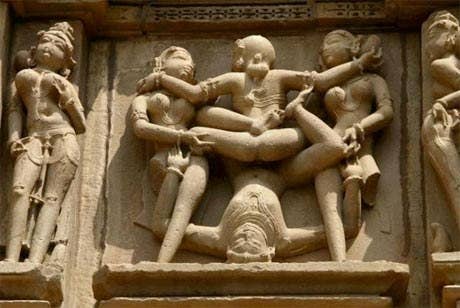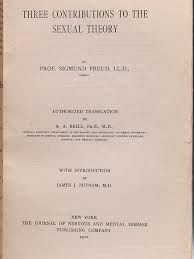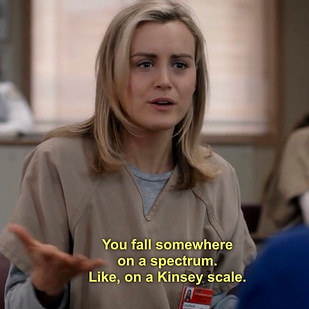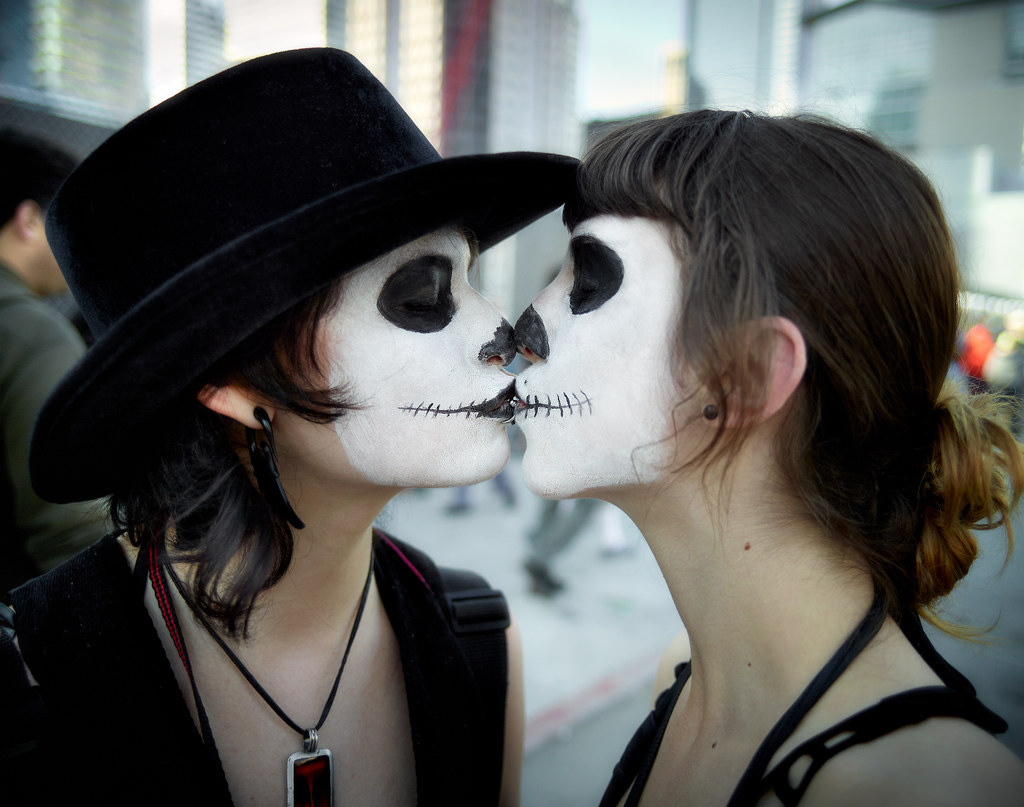What's so wrong with a little bit of history repeating?
View this video on YouTube
In his book, The Bisexual Option, sex psychologist Fritz Klein explains a little history of bisexuality. Klein exhibits that this is nothing new to human society. Not only is this a strong indicator that bisexuality is innate, but it also exhibits how people throughout history have wanted or needed an outlet in society with which they can behave sexually between members of the same sex. Klein specifically notes the “Bloomsberries” and the Greeks. He is thus exhibiting how it is both innate – it has been a human drive for millennia – and modern – something that has never left us and had prominence even in the early 1900s. He conveys “The ‘Bloomsberries’ were almost all - if not all - bisexual not only in action but in psychological outlook. As with the Greeks, it is this outlook that is of special interest.” The Bloomsberries were highly educated members of society that enjoyed bisexual relations and used this cognizantly as a social facilitator. The Greeks used bisexual relations in multiple ways, but even included it in business transactions, to exhibit power dynamics and form a sense of trust or partnership. In these ways, our human history has made a strong case for bisexuality in society and in personal expression that is not overly sexualized but clearly has a role in our highly developed and intellectual world.
Source:
Klein, Fritz. The Bisexual Option. Revised/Expanded ed. New York: Routledge, 2013. Print.
It's all in a name

Our closest relatives still think it's good enough
View this video on YouTube
Rees explains the various sexual patterns of bonobos and other close relatives to humans in the chimpanzee world. As we examine the article, we see that chimpanzees are highly bisexual and give no restriction towards open sexual expression. Rees discusses for example how the female apes will engage in sexual activity with other females regularly. Acts include female genital rubbing, or as those studying primates call it calls it, "genito-genital rubbing." Rees explains In bonobos, females show strong social bonds which they express through sexuality – and male violence towards a female, should it occur, is countered by a concerted attack on the male in question from the other females." This shows how incredibly important physical action is in the female bonobo world, obviously indicating bonobo bisexual encounters to be a supreme social facilitator. It is one way that they resolve conflict (male and female) as well as how they express emotional connections and social ties. It is important for the functioning of their society. I think that similarly, if we were to have the degree of bisexual expression in our society and reject the stigmas that cause us to in turn reject bisexual relations we would be much better off socially. Additionally, the intervention on the part of the women emphasizes how physical acts – sexual or forceful – are an extension of expression of social closeness in bonobos that is incredibly important for the functioning of their complex society and the health and safety of the bonobo species. Lastly, she writes, “Recent accounts of homosexual behaviour in animals (Bagemihl, 1999)
have shown the degree to which uncomfortable pieces of apparent evidence
are ignored by mainstream writers… These examples, however, were
rarely cited and largely ignored. They didn’t fit the image of heterosexual
reproductive sex that is at the heart of modern evolutionary theory.” This calls to question who is should we be studying – the bonobos or the humans? Why does this concept make us so uncomfortable that we abandon scientific integrity and an intergral part of the living world and complex social systems. It is clear that Rees believes that heteronormacy has influenced this rejection of what we can CLEARLY see is innate bisexually. Maybe it is good that we’re studying the bonobos because we have a lot to learn – and maybe we’ll change our behavior patterns!
Source:
Rees, Amanda. "Higamous, hogamous, woman monogamous." Feminist theory 1.3 (2000): 365-370.
Freudian psuedoscience backs it up!

"I'm predominantly heterosexual, but incidentally homosexual. What about you?"

Social Forces and Stigmas
View this video on YouTube
Social forces limit our agency in sexual preference, and stigmas towards bisexuality extend beyond the nonconformity to sterotypical masculine and feminine roles. Because we live in a heteronormative adn therefore heterocentric society, we often ignore that there are more than just the extremes of sexual preference that we exhibit in modern day society - majority heterosexual with a minority homosexual and even fewer bisexual. Because of that, bisexual people are very misunderstood, because the foundation of heterosexuality and even at times homosexuality that has caused the general population to opt for such a strict binary now seems so natural to them that it is hard to understand the nature of the bisexual individual. Monosexuals often condescend bisexual individuals, indicating that they are simply going through a phase that they will eventually mature and grow out of. Women are overly sexualized and their relations are thought of to be "hot" or "cute." On the other hand, the same population is condemning bisexuals, putting for that they are disgusting, overly sexual and incapable of fidelity or romance, or unnatural (which is ironic because it seems that this is not the case). The video above shows from the side of the oppressed that bisexual people really do experience the weight of these social forces. What Alaire and Gaudet set forth to elucidate is that bisexuality is "invisiblized" - meaning that people attempt to ignore their bisexuality and that of others in society, and make it appear to be an ephemeral, unrealistic, and degraded sexual identity that is incapable of sustainment throughout one's life. What we see is that the feelings expressed in the video at the hands of monosexual people influence a drive to invisibilize bisexuality and that the societal structure that we have today inhibits its expression so severely that you are either essentially forced be miserable or forced to completely deny it until you think that it's not a part of you and truly label what is potentially human nature to a ripple or phase in your human development. Also, because we know that they feel this oppression, it is reasonable to conclude that the individual that innately feels an attraction to both sexes but still stands to benefit by not identifying as a bisexual in a society that belittles that population will squelch these urges and chose one side or the other. This could be for whichever side would be more advantageous for them or whichever they are closer to on the Kinsey scale, i.e. a 5 would probably choose their monosexual identity to be a 6 even though homosexuality is not privileged in our society because it is still not a stigmatized as bisexuality is.
Source:
Alarie, Malaine, and Stephanie Gaudet. "I Don't Know If She Is Bisexual or If She Just Wants to Get Attention': Analyzing the Various Mechanisms Through Which Emerging Adults Invisibilize Bisexuality"." Journal of Bisexuality 13.2 (2014). 24 Apr. 2014. Web. 5 Aug. 2014. .
Paradox - Homosexual people also persecute bisexuals
View this video on YouTube
[Please excuse the language employed by the individuals in the video. A lesbian version is also available via https://www.youtube.com/watch?v=xUozcqlhX3w thanks to Arielle Scarcella.]
This video stands testament to the fact that homosexual individuals hold strong prejudices toward members of the bisexual or pansexual communities. This extends not only to believing that they would be less desirable or preferable partners but that they are "liars" (as one man in the video was absolutely admit about), confused (a sentiment reflected also by the monosexual-heterosexual community), and weird. One individual in the video intonated that it is "It's hot when a girl is bisexual to another guy, but I think it's just weird when a guy is bisexual to me, because they're gay, and still having sex with a girl." This shows that this standard flows both ways, equal discrimination against bisexuals encountered from both monosexual groups, but from a different perspective. Both the lesbians in the video attached above (though not embedded) and gay men heavily condemned the bisexual community but more so because many felt that they had been "deceptive" in their orientation and limited their datability in the eyes of the homosexuals. Much of the stigma that surrounds bisexuals has made them less attractive to both monosexual communities, and because of this homosexual people seem off put that they would initially appear to be part of the homosexual community at first and therefore be potentially datable, but subsequently that interest would be lost because the homosexuals did not want to date a bisexual due to these stigmas. In this way they have accepted and perpetuated the condemnation of the bisexual, an odd occurrence given their situation because homosexuals are they are also condemned by society for their orientation. What Morgenstern states "Bisexuals encounter the same sorts of prejudice as gay people. However, we encounter it within the gay community as well as in the straight world.... misunderstood and ostracized by both gay and straight people." He also goes on to say "We feel even more hurt when gays reject us than when straights do, since we feel that gay people know better.... The word 'bisexual' has been added to the masthead [of the gay rights front], but we don't feel truly included or accepted." The ways in which the gay and straight community come together to eschew bisexual people is a strong social force in repression of the bisexual nature that makes it feel easier to drop your bisexual identity later in life - in essence perpetuating the wrongful claim that its nature is a phase ironically because of the claim's existence and the stigma it perpetuates - rather than carry the weight of that burden the rest of one’s life, limiting ones access to partners and questioning their sense of self. These views epitomize the oppression of the bisexual individual, a key aspect of understanding their experience in the world as well as the repressed nature of bisexuality that we find in individuals just forming their sexual identities as well as those that have accepted a different sexual identity later on in life.
Source:
Morgenstern, J. (2004, May-June). Myths of bisexuality. Off our backs.
Sexual and romantic identities are not the same.
View this video on YouTube
In a distinctly different chapter of his book, Klein made a wonderful clarification that is integral for understanding the bisexual world. Via his “Bisexual-Intimacy Scale” he put forth that there was a difference between sexual intimacy and emotional intimacy. Effectively, he classified our abilities to identify with either gender more than the other via two separate entities – a sexual self and a romantic self. These identities don’t necessarily have to align. An individual may feel equally attracted to both sexes sexually but only romantically attracted to one. This is what I theorize is one of the reasons we can readily reject our bisexuality. While we may feel attracted to both genders in one way, our propensity for just one doesn’t make entirely choosing just one sexually or romantically in preference seem so extreme. This also helps us to understand complex social relations, like female-female friendships that allow for a large degree of romance because they do not have the stereotype of needing to embrace only a male figure while men do not facilitate friendships that seem to carry a romantic degree because it is not socially acceptable and works against their homophobic stereotypes. In large part, a bi-romantic nature may have served the purpose of easing social tensions and facilitating a greater sense of unity in early human populations while the sexual aspect of it may have breed pleasure and allowed ancients to resolve conflict easily – again showing how bisexual nature is innate and how valuable its acceptance could be for society.
Source:
Klein, Fritz. The Bisexual Option. Revised/Expanded ed. New York: Routledge, 2013. Print.
Romance Between Men Was Not Always Uncommon

"Compulsory Bisexuality" - On the other hand, we have to embrace it, but are we REALLY embracing it?





![[Please excuse the language employed by the individuals in the video. A lesbian version is also available via https://www.youtube.com/watch?v=xUozcqlhX3w thanks to Arielle Scarcella.]
This video stands testament to the fact that homosexual individuals hold strong prejudices toward members of the bisexual or pansexual communities. This extends not only to believing that they would be less desirable or preferable partners but that they are "liars" (as one man in the video was absolutely admit about), confused (a sentiment reflected also by the monosexual-heterosexual community), and weird. One individual in the video intonated that it is "It's hot when a girl is bisexual to another guy, but I think it's just weird when a guy is bisexual to me, because they're gay, and still having sex with a girl." This shows that this standard flows both ways, equal discrimination against bisexuals encountered from both monosexual groups, but from a different perspective. Both the lesbians in the video attached above (though not embedded) and gay men heavily condemned the bisexual community but more so because many felt that they had been "deceptive" in their orientation and limited their datability in the eyes of the homosexuals. Much of the stigma that surrounds bisexuals has made them less attractive to both monosexual communities, and because of this homosexual people seem off put that they would initially appear to be part of the homosexual community at first and therefore be potentially datable, but subsequently that interest would be lost because the homosexuals did not want to date a bisexual due to these stigmas. In this way they have accepted and perpetuated the condemnation of the bisexual, an odd occurrence given their situation because homosexuals are they are also condemned by society for their orientation. What Morgenstern states "Bisexuals encounter the same sorts of prejudice as gay people. However, we encounter it within the gay community as well as in the straight world.... misunderstood and ostracized by both gay and straight people." He also goes on to say "We feel even more hurt when gays reject us than when straights do, since we feel that gay people know better.... The word 'bisexual' has been added to the masthead [of the gay rights front], but we don't feel truly included or accepted." The ways in which the gay and straight community come together to eschew bisexual people is a strong social force in repression of the bisexual nature that makes it feel easier to drop your bisexual identity later in life - in essence perpetuating the wrongful claim that its nature is a phase ironically because of the claim's existence and the stigma it perpetuates - rather than carry the weight of that burden the rest of one’s life, limiting ones access to partners and questioning their sense of self. These views epitomize the oppression of the bisexual individual, a key aspect of understanding their experience in the world as well as the repressed nature of bisexuality that we find in individuals just forming their sexual identities as well as those that have accepted a different sexual identity later on in life.
Source:
Morgenstern, J. (2004, May-June). Myths of bisexuality. Off our backs.](https://img.youtube.com/vi/XUXzNowXVwo/mqdefault.jpg)

